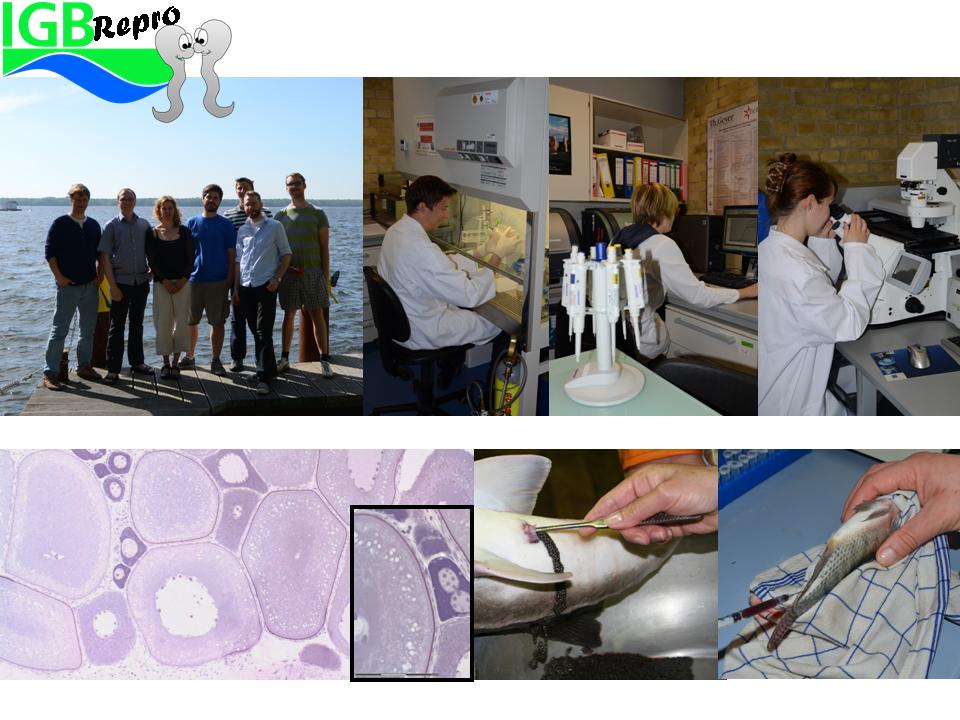Work group Sustainable aquaculture
Department of Ecophysiology and Aquaculture
Leibniz Institute of Freshwater Research and Inland Fisheries
Contact
Dr. Sven Würtz
wuertz@igb-berlin.de
Phone: +49 30 64181614
Address
Department of Ecophysiology and Aquaculture
Müggelseedamm 301
12587 Berlin (Germany)
Group description
The Leibniz-Institute of Freshwater Ecology and Inland Fisheries (IGB) is the largest institute dedicated to the research on freshwater resources in Germany (www.igb-berlin.de) and is affiliated to all three universities in Berlin (Free University, Humboldt University, Technical University) and the MSc programme Fish Biology, Fisheries and Aquaculture at the Humboldt Universities. The Department of Ecophysiology and Aquaculture comprises six work groups (6 senior scientist, more than 20 PhD, MSc and BSc students) focusing on aquaculture research in the field of reproduction, stress physiology, nutrition, parasitology, disease control, ecotoxicology and genetics of fish.
One central research focus addresses the molecular mechanisms of neuroendocrine regulation of growth processes, reproduction and stress physiology and their importance in applied aquaculture:
· Endocrine regulation of gonadogenesis
· Induction of gonad maturation (puberty)
· Broodstock diets and nutrition
· Endocrine regulation of appetite and potential application in aquafeed formulation and feeding
· Endocrine regulation of growth and its application to increase growth performance, i.p. food conversion
· Stress physiology – Monitoring and prevention during production, implication on health status and animal welfare
· Toxicology of metabolites and by-products in recirculation systems
Experimental facilities comprise 12 recirculation systems and small sized experimental units with aquaria. Designated for experimental research, modules can integrate a set of mechanic (sedimenter, drum filter, protein skimmer) and biologic (moving bed filter, trickling filter) water treatment units and disinfection systems (UV, ozonation). Labs are equipped for molecular biology (qPCR, sequencing, laser dissection microscope, CASA), cell culture techniques, analytical chemistry (GC-MS; LC-MSMS, UHPLC-qTOF), nutrition analysis and water chemistry.
Relevant publications
1. Hermelink, B., Wuertz, S., Rennert, B., Kloas, W., Schulz, C. (2013): Temperature control of pikeperch (Sander lucioperca) maturation in recirculating aquaculture systems – induction of puberty and course of gametogenesis. Aquaculture 400 – 401, 36 – 45
2. Trubiroha, A., Kroupova, H., Wuertz, S., Kloas, W. (2012): Up-regulation of gonadotropin mRNA-expression at the onset of gametogenesis in the roach (Rutilus rutilus): Evidence for an important role of brain-type aromatase (cyp19a1b) in the pituitary. Gen Comp Endocrinol 178(3), 529 – 538
3. Kroupova, H., Trubiroha, A., Wuertz, S., Frank, S.N., Sures, B., Kloas, W. (2012): Nutritional status and gene expression along the somatotropic axis in roach (Rutilus rutilus) infected with the tapeworm Ligula intestinalis. Gen Comp Endocrinol 177(2), 270 – 277
4. Kroupova, H., Trubiroha, A., Wuertz, S., Kloas, W. (2011): Stage-dependent differences in RNA composition and content affect the outcome of expression profiling in roach (Rutilus rutilus) ovary. Comp Biochem Phys A 159(2), 141 – 149
5. Hermelink, B., Wuertz, S., Trubiroha, A., Rennert, B., Kloas, W., Schulz, C. (2011): Influence of temperature on puberty and maturation of pikeperch, Sander lucioperca. Gen Comp Endocrinol 172(2), 282 – 292
6. Trubiroha, A., Kroupova, H., Wuertz, S., Frank, S.N., Sures, B., Kloas, W. (2010): Naturally-induced endocrine disruption by the parasite Ligula intestinalis (Cestoda) in roach (Rutilus rutilus). Gen Comp Endocrinol 166(2), 234 – 240
7. Wuertz, S., Groper, B., Gessner, J., Kruger, T., Luckas, B., Kruger, A. (2009): Identification of caviar from increasing global aquaculture production – Dietary capric acid as a labelling tool for CITES implementation in caviar trade. Aquaculture 298(1-2), 51 – 56
8. Trubiroha, A., Wuertz, S., Frank, S.N., Sures, B., Kloas, W. (2009): Expression of gonadotropin subunits in roach (Rutilus rutilus, Cyprinidae) infected with plerocercoids of the tapeworm Ligula intestinalis (Cestoda). Int J Parasitol 39(13), 1465 – 1473
9. Pietsch, C., Neumann, N., Knopf, K., Wuertz, S., Kloas, W. (2009): Progestogens cause immunosuppression of stimulated carp (Cyprinus carpio L.) leukocytes in vitro. Comp Biochem Phys C 150(1), 16 – 24
10. Opitz, R., Schmidt, F., Braunbeck, T., Wuertz, S., Kloas, W. (2009): Perchlorate and ethylenethiourea induce different histological and molecular alterations in a non-mammalian vertebrate model of thyroid goitrogenesis. Mol Cell Endocrinol 298(1-2), 101 – 114
11. Kloas, W., Urbatzka, R., Opitz, R., Würtz, S., Behrends, T., Hermelink, B., Hofmann, F., Jagnytsch, O., Kroupova, H., Lorenz, C., Neumann, N., Pietsch, C., Trubiroha, A., van Ballegooy, C., Wiedemann, C., Lutz, I. (2009): Endocrine disruption in aquatic vertebrates. Ann N Y Acad Sci 1163, 187 – 200
12. Wuertz, S., Nitsche, A., Jastroch, M., Gessner, J., Klingenspor, M., Kirschbaum, F., Kloas, W. (2007): The role of the IGF-I system for vitellogenesis in maturing female sterlet, Acipenser ruthenus Linnaeus, 1758. Gen Comp Endocrinol 150(1), 140 – 150
13. Wuertz, S., Gessner, J., Kirschbaum, F., Kloas, W. (2007): Expression of IGF-I and IGF-I receptor in male and female sterlet, Acipenser ruthenus – Evidence for an important role in gonad maturation. Comp Biochem Phys A 147(1), 223 – 230
14. Wuertz, S., Gaillard, S., Barbisan, F., Carle, S., Congiu, L., Forlani, A., Aubert, J., Kirschbaum, F., Tosi, E., Zane, L., Grillasca, J.P. (2006): Extensive screening of sturgeon genomes by random screening techniques revealed no sex-specific marker. Aquaculture 258(1-4), 685 – 688
15. Jastroch, M., Wuertz, S., Kloas, W., Klingenspor, M. (2005): Uncoupling protein 1 in fish uncovers an ancient evolutionary history of mammalian nonshivering thermogenesis. Physiol Genomics 22(2), 150 – 156
